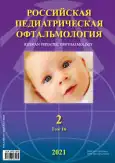Conjunctivities of newborns
- Authors: Saidasheva E.I.1,2, Buianovskaia S.V.2
-
Affiliations:
- North-Western State Medical University named after I.I. Mechnikov
- Children’s city multidisciplinary clinical specialized center for high medical technologies
- Issue: Vol 16, No 2 (2021)
- Pages: 31-39
- Section: Clinical recommendations
- URL: https://journal-vniispk.ru/1993-1859/article/view/59301
- DOI: https://doi.org/10.17816/rpoj59301
- ID: 59301
Cite item
Abstract
The article is focused on the peculiarities of the clinical course of separate forms of neonatal conjunctivitis, depending on the etiological factor. It was found that more often the disease refers to nosocomial eye infection and bacterial nature. We performed the bacteriological analysis of the contents of the conjunctival cavity of 50 newborn patients being treated in the neonatal department. Our analysis indicated the leading role of gram-positive bacteria — Staph. epidermidis (59.7%) and Staph. aureus (21.7%) in the development of the inflammatory process. The share of other types of pathogens, including gram-negative minor and various pathogens, is from 0.54% to 3.2%.
The cause of nosocomial infection is considered to be the pathogen that circulates in the department and acquires the features of a hospital strain. These are consistent with the results of similar studies conducted by both domestic and foreign clinicians, which are also presented in the article. Particular attention is paid to the causative agents of intrauterine infections that are dangerous for the anterior section: gonococcus, chlamydia, herpes simplex, etc. These agents often cause serious diseases in newborns (gonoblenorrhea, ophthalmic chlamydiosis, and ophthalmic herpes), in which the cornea and vision are often affected.
The article highlights the measures of primary prevention of intrapartum infection of the ocular surface in newborns, adopted in Russia. The paper presents modern approaches to selecting drugs for local antibacterial therapy of neonatal conjunctivitis, considering age restrictions for their use. Methods of laboratory diagnostics and their validity for the etiology of conjunctivitis have been described in detail. For example, the bacteriological method (inoculations in various culture media) is considered a reference (specificity 100%). The culture medium can be used to isolate bacteria, chlamydia, and mycoplasma, which allows getting clear results even with a minimal amount of microflora
Keywords
Full Text
##article.viewOnOriginalSite##About the authors
Elvira I. Saidasheva
North-Western State Medical University named after I.I. Mechnikov; Children’s city multidisciplinary clinical specialized center for high medical technologies
Email: esaidasheva@mail.ru
ORCID iD: 0000-0003-4012-7324
SPIN-code: 7800-3264
Dr of Med. Sci, Professor
Russian Federation, St. PetersburgSvetlana V. Buianovskaia
Children’s city multidisciplinary clinical specialized center for high medical technologies
Author for correspondence.
Email: solncemia@mail.ru
ORCID iD: 0000-0001-7503-2611
SPIN-code: 6981-9826
http://www.researcherid.com/rid/P-6836-2014
Candidate of Medical Sciences
Russian Federation, St. PetersburgReferences
- Ivanov DO, editor. Klinicheskie rekomendatsii (protokoly) po neonatologii. Saint Petersburg: Inform-Navigator; 2016. 462 p. (In Russ).
- Rutar T. Neonatal’nyy kon”yunktivit. In: Hoyt KS, Taylor D. Paediatric ophthalmology. Moscow: Panfilov’s publishing house; 2015. P. 104–108. (In Russ).
- Shabalov NP. Neonatologiya. Study guide. Moscow: GEOTAR-Media; 2016. 736 p. (In Russ).
- Arestova NN, Katargina LA, Yani EV. Conjunctivitis and dacryocystitis in the children: the clinical characteristic and modern approaches to the treatment. Russian Pediatric Ophthalmology. 2016;11(4):200-206. (In Russ). doi: 10.18821/1993-1859-2016-11-4-200-206
- Shukhov VS, Baibarina EN, Ryumina II, Zubkov VV. Antimikrobnaya terapiya u detei. Moscow: GEOTAR-Media; 2016. 314 p. (In Russ).
- Borer A, Livshiz-Riven I, Golan A, et al. Hospital-acquired conjunctivitis in a neonatal intensive care unit: Bacterial etiology and susceptibility patterns. Am J Infect Control. 2010;38(8):650-652. doi: 10.1016/j.ajic.2010.01.002
- Volodin NN, Sukhikh GT, editors. Bazovaya pomoshch’ novorozhdennomu – mezhdunarodnyy opyt. Moscow: GEOTAR-Media; 2008. 208 p. (In Russ).
- Chajidis AK, editor. Pediatricheskiy i neonatal’nyy formulyar lekarstvennykh sredstv (detskii mnogoprofil’nyi statsionar): guidelines for healthcare managers and physicians. Saint Petersburg: GEU; 2020. 382 p. (In Russ).
- Forbes GB, Forbes GM. Silver nitrate and the eyes of the newborn: crede contribution to preventive medicine. Am J Dis Child. 1971;121(1):1–3. doi: 10.1001/archpedi.1971.02100120037001
- Plotzko E, Bowman L, Abelson M, et al. Clinical Study Group Phase 3 safety comparisons for 1,5% azithromycin in polymeric mucoadhesive eye drops versus 0,3% tobramycin eye drops for bacterial conjunctivitis. Invest Ophthalmol Vis Sci. 2007;48(8):3425–3429. doi: 10.1167/iovs.06-1413
- Red Book: report of the Committee on Infectious Diseases. 30th ed. Elk Grove Village, IL: American Academy of Pediatrics; 2015. 1151 p.
- Galeeva GZ, Samoylov AN, Musina LT. The differential approach to the treatment of various clinical forms of dacryocystitis in newborn infants. Russian pediatric ophthalmology. 2013;(2):22–26. (In Russ).
- Evsyukova II. Vnutriutrobnaya khlamidiynaya infektsiya (diagnostika, klinika, lechenie). Saint Petersburg; 2007. 44 p. (In Russ).
- Maychuk YuF. Kon”yunktivity. Sovremennaya lekarstvennaya terapiya: a guide for doctors. Moscow; 2014. 56 p. (In Russ).
- Katargina LA, Saidasheva EI. Kon”yunktivity novorozhdennykh. In: Ivanov DO, editor. Rukovodstvo po perinatologii. 2nd ed. Saint Petersburg: Inform-Navigator; 2019. 1592 p. (In Russ).
- Saidasheva EI, Buyanovskaya SV, Kovshov FV, et al. The application of modern fluoroquinilones for the treatment of bacterial eye infections in the young children. Russian pediatric ophthalmology. 2015;(1):22–25. (In Russ).
- Vorontsova TN, Brzheskiy VV, Mikchailova MV. Microflora of conjunctiva in children and its sensitivity and resistance to antibacterial drugs. Ophthalmology in Russia. 2012;9(1):83–91. (In Russ). doi: 10.18008/1816-5095-2012-1-83-91
- Gusarevich OG, Aleksandrova SE. Safety and efficacy of “Azidrop” eye drops in treatment of bacterial conjunctivitis in newborn children. Ophthalmology Journal. 2015;8(3):83–83. (In Russ). doi: 10.17816/OV2015383-85
- Lessa FS, Edwards JR, Fridkin SK, et al. Trends in incidence of late-onset methicillin-resistant Staphylococcus aureus intensive care units: data from the National Nosocomial Infections Surveillance System, 1995-2004. Pediatr Infect Dis J. 2009;28(7):577–581. doi: 10.1097/INF.0b013e31819988bf
- Bremond-Gignac D, Nezzar H, Bianchi PE, et al. Efficacy and safety of azithromycin 1.5% eye drops in paediatric population with purulent bacterial conjunctivitis. Br J Ophthalmol. 2014;98(6):739–745. doi: 10.1136/bjophthalmol-2013-303888
Supplementary files






